If you're preparing to embark on your first river cruise, we've got tips that can help! Check out our First Time Cruise Tips for River Cruises.

Interested in river cruising but not sure where to start? You've come to the right place!
As longtime avid travel lovers (and travel writers!), Alain and I actually embarked on our first river cruise not too long ago. We prepared well ahead of time using our collective extensive travel experience, and learned a lot in the process of planning and going on that first river cruise.
Now we're excited to share ALL of the tips and tricks we've learned and used that can help you, too, have the best first river cruise experience!
In this article, we'll be sharing why we love river cruising and why you might too, a comprehensive timeline to help you plan your first river cruise, what to wear and what to pack, information about river cruise cabins and excursions, and we answer many frequently asked questions about river cruises.
Jump to:
- Why go on a river cruise?
- Timeline for planning your first river cruise
- What to wear on your first river cruise
- River cruise excursions
- River cruise ship cabins
- River cruise tips and gratuities
- Things to keep in mind: river cruises vs. ocean cruises and other travel methods
- A few unexpected things to note about river cruising
- Embarkation and disembarkation
- Additional first time river cruise FAQs
- More helpful cruise travel articles
Why go on a river cruise?
To be completely honest, a river cruise had never been on our personal travel bucket list. We've never considered ourselves "cruisers," but when the opportunity to experience an AmaWaterways river cruise came along, we couldn't pass up the opportunity.
We are SO glad we did it! And, we are now big fans of river cruises.
Here are a few reasons why you might enjoy a river cruise, too.
- It's an efficient way to see several cities in one trip. River cruises usually spend one or two nights in each port, so depending on the length of your cruise, you could be visiting between five to seven different cities.
- Unpack once. One of the best things about traveling via river cruising, in my opinion, is that you only have to unpack once. Unlike standard travel to visit several different cities in one trip, you don't have to keep unpacking and packing, checking into different hotel rooms in each city. With a river cruise, the ship is your hotel on the water. Unpack once, and enjoy your trip!
- Personalized service. Because there are fewer guests, there is greater personal service on river cruises. I love traveling on my own, but the incredible personal service on river cruises will make you feel like VIP guests! The staff on our river cruise remembered our names and often our personal food & drink prefernces, always greeted us with smiles, quickly and happily helped us with any requests or questions we had, and simply treated us like royalty.
- It gives you a glimpse of each city to help plan future travels. By spending 1 or 2 days in each city, you get enough time to experience the local culture. For us, we fell in love with a couple of cities and know we want to visit again for extended trips. And, we also learned we didn't actually love a city we thought we might, so it saves us time and money that we might have spent on hotels and transportation if we had stayed in that city for a few days.
- More space to breathe. Even though river cruise ships are smaller to accommodate fewer guests, there is still more room to relax on the boat. Fewer bodies means more breathing room.
- Included daily excursions. River cruises offer small group, in-depth excursions in each port. These are an amazing way to really get to know and experience the local culture, cuisine, art, architecture, history, and lifestyle.
Timeline for planning your first river cruise

Ready to start planning your first river cruise? Here's a general timeline to help you get started.
12-18 Months Before Departure
- Research cruise options: Explore various cruise lines, routes, and destinations to find one that aligns with your travel interests.
- Set a budget: Factor in cruise fares, airfare, pre- and post-cruise stays, excursions, dining, and tips.
- Identify travel dates: Consider the best time to cruise based on weather, seasonal events, and personal schedules.
- Check passport validity: Ensure everyone's passports have at least 6 months validity beyond your return date. If not, renew them now!
9-12 Months Before Departure
- Book your cruise: Secure your reservation early to get the best cabin selection and promotional offers.
- Review cancellation policies: Understand the terms of your booking and look into travel insurance for added protection.
- Research flight options: If flights aren’t included in your cruise package, start comparing prices and routes.
- Start monitoring visa requirements: Confirm whether you need visas for any countries you’ll visit.
6-9 Months Before Departure
- Confirm or apply for passports: In case you haven't yet, apply for or renew passports as needed, allowing time for processing.
- Explore excursion options: Review optional shore tours offered by the cruise line and decide which ones align with your interests.
- Reserve pre- or post-cruise accommodations: Consider spending a few extra days in your embarkation or disembarkation cities.
3-6 Months Before Departure
- Book flights and transfers: Finalize your travel arrangements, including flights and transportation to and from the ship.
- Select excursions: Lock in popular tours early to avoid missing out.
- Update health requirements: Check vaccination or COVID-19 requirements and any country-specific health guidelines.
2-3 Months Before Departure
- Start planning your packing list: Consider the climate, dress codes for onboard dining, and excursion activities. Check weather apps to watch the weather at your destinations.
- Purchase travel essentials: Invest in comfortable walking shoes, international travel adapters, and rain gear if needed. Make sure you have luggage, packing cubes, Air Tags, and other travel essentials. Order anything you are missing or need to have replaced.
- Check currency exchange rates: Decide if you’ll bring local currency and explore options for obtaining them overseas.
1 Month Before Departure
- Review all travel documents: Ensure you have passports, visas, boarding passes, and excursion tickets printed and saved digitally.
- Set up travel alerts: Notify your bank and credit card companies about your travel dates to avoid issues.
- Confirm reservations: Double-check flights, accommodations, and cruise details for any changes.
1-2 Weeks Before Departure
- Finalize packing: Stick to a minimalist wardrobe with layers for varying temperatures.
- Prepare travel snacks and entertainment: Download books, podcasts, music, and movies for downtime during travel. Our fave travel snacks to pack: granola bars, nuts, dehydrated fruit.
- Double-check luggage limits: Review the cruise line’s luggage policy and airline restrictions.
- Download cruise app: Most cruiselines will have an app that you can download to your phone. Download this now and familiarize yourself with the app features.
Day of Departure
- Arrive early: Allow plenty of time for airport security and check-in.
- Carry essentials in a day bag: Keep passports, cruise documents, medications, and valuables in your personal item carry-on.
During the Cruise
- Stay organized: Keep a copy of the cruise schedule handy for daily activities and excursions. This is often on the cruise line app!
- Attend the welcome meeting: Most river cruises have an initial welcome and safety meeting for guests. Be sure to attend so you know the ship's safety procedures and so you can familiarize yourself with the key crew members, including the cruise manager/cruise director, the captain, and others.
- Be on time: Always make sure you are on time for meals and for excursion meet-ups, and All Aboard times.
- Take advantage of onboard offerings: Attend onboard offerings such as wellness programs and fitness classes, cooking demonstrations, and special after dinner events to enhance your experience.
- Take time to relax: Balance excursions with moments to enjoy the ship's amenities and scenic views. One of our favorite things about river cruising is enjoying the views of the different towns we pass through on sailing days.
After the Cruise
- Organize photos and keepsakes: Create an album or scrapbook of your trip memories.
- Review travel expenses: Update your budget and track spending for future trips.
- Share feedback: Complete post-cruise surveys to help cruise lines improve.
What to wear on your first river cruise

If you're like me, you're scouring the internet to find photos of what people wear on river cruises.
Here are a few of our photos from our own river cruise trips and excursions to give you some ideas of what worked for us.
Plus, we've got a whole article on what to pack for a European river cruise.
In general, you'll want to pare down your wardrobe to the essentials. There's not a lot of room on most cruise ships, and you won't want to be lugging around tons of luggage filled with clothes you'll never wear.
The basics include:
- Comfortable casual clothing for day excursions and lounging around the ship. This includes t-shirts or other casual tops, shorts, casual pants/jeans. I brought one sweatshirt for chilly weather (above, middle top photo) and I'm glad I did. It was perfect for sitting out on the sun deck when it was sunny but very windy and cold.
- Dressier clothing for dinners. Some cruise ships have dress codes for meals, so be sure to check with your particular cruiseline. For dinners onboard river cruises, most people tend to dress up a bit. Think business casual. This means slacks and button-down shirts for men (with or without jackets), and dresses or blouses and slacks for women.
- One "fancy" outfit for a special dinner. Some people bring one extra nice dress or suite and tie for a Chef's Table, Last Night Gala, or Captain's Dinner.
- Three pairs of shoes: stick with one pair of sneakers/trainers for most day excursions, one pair of dress shoes for dinners, and either comfortable sandals for late spring/summer/sunny destination cruises or waterproof boots for fall/winter/colder climate cruises. I wear comfortable shoes that I also feel comfortable doing light workouts in; if you intend to do more strenuous workouts, pack a pair of more athletic sneakers. Also keep in mind whether you'll need hiking boots or snow boots for your particular cruise and excursions.
- Swimsuit: many river cruises have a small pool and/or hot tub onboard.
NOTE: many river cruise ships offer laundry service onboard at extra cost. This can help you maintain a smaller wardrobe when packing.
River cruise excursions
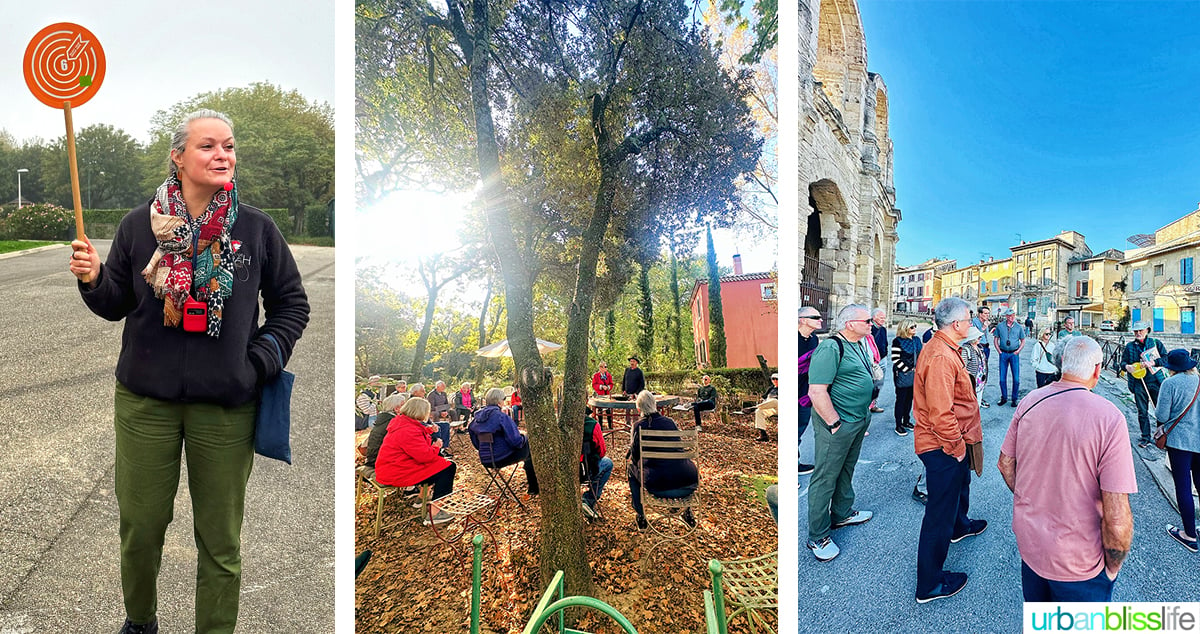
One of our favorite things about river cruises are the excursions. Because these are a big part of river cruise travels. I suggest taking the time to research the excursion options before selecting your cruise.
Types of excursions: Depending on the cruise, there may be culinary excursions, hiking or biking excursions, city walking tours, historic or culture-focused excursions, or shopping excursions
Length of excursions: Excursions typically last 2-4 hours and often include guided walking tours. Many are included in the cruise fare, with premium options available for an extra cost.
Excursion times: On our AmaWaterways river cruise, there were often three options for morning excursions and three options for afternoon excursions. The morning ones started around 9am and finished by noon. The afternoon excursions started around 12-12:30pm and ended anytime between 2 and 4:30pm. They were each different enough that we never felt like we were missing out; there was always one excursion that fit our particular travel style and interest more than the others.
Activity levels: Also for AmaWaterways, and this may be similar on other river cruise excursions, there were different activity levels so you could choose one that fit you.
There were active levels for those who wanted more physical activity; regular levels for people like us who wanted some activity but not at the break-a-sweat level; and gentle levels for those who might have some mobility issues or wanted to take a slower pace.
Excursion locations: Most excursions are located less than an hour's drive away from that day's port. For some excursions, you'll be meeting with a local guide right outside on the dock and then take a short walk to the destination. For others, you may meet the guide and then board a large chartered bus which will take you to the excursion destination.
Guides: most excursions include local guides, which is great because they know the history of the area, the culture, and can answer questions you may have. Most local tour companies also provide guides who are entertaining, with outgoing and energetic personalities, which helps make the excursions fun.
River cruise ship cabins

Cabins on river cruise ships are typically smaller than ocean cruise staterooms but they tend to maximize every inch of space.
They usually include modern amenities such as comfortable bedding, ensuite (but still compact!) bathrooms, storage space, USB ports and a decent number of outlets.
Most cruise ships have a variety of stateroom levels so you can choose one that best suits your needs and budget. The more expensive ones tend to have often larger windows or balconies.
Keep in mind that on river cruises, you are usually spending most of the time outside of your stateroom. That said, we love having a balcony and will always pay a little extra if we need to in order to get one.
River cruise tips and gratuities
Many river cruise lines offer a hassle-free option by including gratuities in the overall fare, particularly for onboard dining and housekeeping staff.
However, some river cruise lines leave tipping at your discretion, allowing you to reward service staff based on your personal experience.
If tips aren’t prepaid, cruise lines often recommend a daily rate per person. This typically ranges from €10 to €15, which is then divided among the crew. You can usually add these gratuities directly to your onboard account for easy processing.
In addition to general crew gratuities, consider offering a separate tip to exceptional staff members, such as your cruise director, who oversees your travel experience and coordinates excursions.
Local guides and bus drivers for excursions and tours typically appreciate small cash tips. This is usually around €1-€2 per person for drivers and €2-€5 per person for guides.
While tipping practices may vary by cruise line and destination, having small denominations of euros or the local currency on hand will ensure you’re always prepared to show your gratitude.
Things to keep in mind: river cruises vs. ocean cruises and other travel methods

As much as we love river cruising, depending on your travel style and vacation goals, it may not be the best fit for every travel situation. Here are some things to consider:
- Limited entertainment options: Unlike large ocean cruise ships with casinos, theaters, and multiple entertainment venues, river cruise ships offer a more relaxed atmosphere with fewer onboard activities, which may not appeal to you if you're looking for a lively, bustling environment with tons of entertainment options onboard.
- Small ship size: While the intimate size of river cruise ships is a plus for many, it may feel restrictive if you prefer the vast amenities and variety offered by larger ocean liners. Cabin space is also typically more compact than hotel rooms or ocean cruise staterooms.
- Less flexibility in itineraries: River cruises follow a set schedule with fixed ports of call and limited free time in each destination. If you prefer to independently explore cities at your own pace, you might find the structured itinerary too confining.
- Seasonal and water level constraints: River cruises operate best during certain months, with low water levels in late summer or high water levels in spring potentially causing itinerary changes or ship transfers. Weather-related disruptions can be frustrating according to those we know who have had to deal with them.
- Potentially higher per-day costs: Although many amenities are included, the upfront cost of a river cruise can be higher than comparable land vacations or ocean cruises. If you are very budget-conscious and prefer more flexible options that meet your budget needs, a river cruise may not be for you.
While river cruises offer a unique and enriching way to explore Europe, it's good to know about these potential drawbacks so you can select the best vacation style to suit your preferences.
A few unexpected things to note about river cruising

There were a few surprises and things we didn't expect to encounter on river cruises but mostly found interesting and/or super cool.
- Don't bring a hair dryer, flat iron or curling iron. Most river cruise ships will have a hair dryer in each stateroom. And due to electricity requirements, guests are usually NOT allowed to bring their own curling irons or flat irons onboard. However, your cruise ship may have some that are designed to work with the ship's electricity requirements that you can check out from reception and use during the cruise. Be sure to ask ahead of time!
- Going through locks for the first time is an experience not to miss. Even if you have no interest in engineering whatsover, watching a river cruise ship go through a lock for the first time can be fascinating.
- Ships dock right next to one another. Once, I opened the curtains to our balcony to find myself staring into the dining room of another cruise ship. And several diners staring back at me. It's so weird! This means that sometimes, you may be going through another cruise ship to get to shore. Or, you may have passengers from another cruise ship going through your cruise ship to go ashore. And, that for those hours when your ships are docked right next to each other, you may not have the beautiful river view you get otherwise.
Embarkation and disembarkation
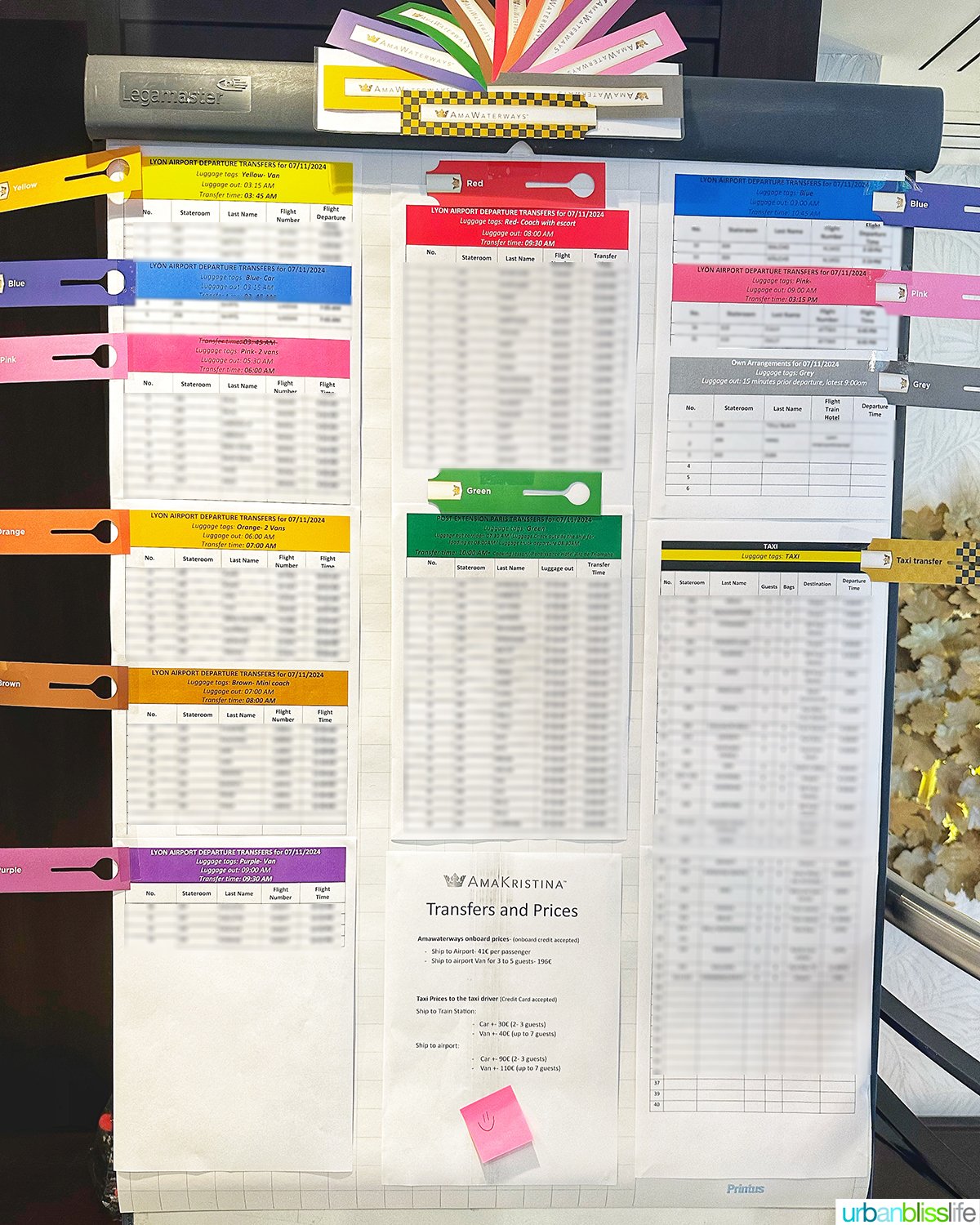
I'm so impressed by the organization and communication that occurs in the whole embarkation and disembarkation process for river cruises. Ours on AmaWaterways ran like clockwork and was executed perfectly!
Embarkation: You'll be given a time when you can check into your stateroom. Most people arrive before then and you can usually drop off your luggage with the ship staff and they'll tag it for your room. Then when you check in, your luggage will be waiting for you in your room.
Disembarkation: two nights before disembarkation day, you'll be notified of the disembarkation schedule. For AmaWaterways, they have a chart organized by departure times and modes of transportation that you can check to make sure you're in the right departure timeslot.
It's also color coordinated with luggage tags that you'll need to attach to all of your luggage pieces. So it's vital that you give your cruise ship personnel your departure plan info so they can ensure you and your luggage are slotted into the right time.
TIP: plan to arrive the day before your embarkation day (first day of the cruise). This helps ensure you can still cruise in case your flight is delayed or if there are weather delays for trains, etc. on the way to the departing port.
Additional first time river cruise FAQs
Most cruises cover accommodations, meals, select beverages, guided shore excursions, and onboard entertainment. Airfare, gratuities, and optional excursions may be additional.
River cruising is smooth and calm, with minimal motion compared to ocean cruises, making seasickness rare.
Spring (April-May) and fall (September-October) offer mild weather and fewer crowds, while summer is ideal for warm temperatures and holiday festivities.
Yes, most cruise lines accommodate dietary preferences, including vegetarian, gluten-free, and allergy-sensitive meals; it’s best to inform them in advance.
Moderate walking is common, often on cobblestone streets and uneven terrain, though some cruises offer gentler options for less active guests.
We hope this helps you plan for your first river cruise!
Got any additional questions that we haven't covered? Post them in the comments below and we will try to answer them!
✈️ Planning a trip?
Here are my favorite items and resources I use whenever I travel.
🧳 Away Luggage - I've traveled all over the world with Away luggage and can't say enough about their durability and style.
🎒 Backpack - This is my go-to travel backpack. It has pockets everywhere and enough space to fit everything from my laptop to extra shoes.
📍Apple Air Tags - I always hide these airtags away in my luggage, especially if I check bags. That way I can track them and know exactly where they are.
👚 Packing cubes - Take the stress out of packing and make sure everything fits in your bags with this set of compression packing cubes.
⚡️Portable charger - I always travel with a portable power bank for my devices, and I've found this one to be the most reliable and long-lasting.
🔌 Travel adapter - Planning to travel to multiple countries? I use this all-in-one international travel adapter to make sure my devices work wherever I go.
🛩 Flights - I've found the best savings savings on flights here.
🏨 Hotel - I always snag the best lodging deals with this booking tool.
🚙 Rental cars - You can get some great savings on rental cars on this site.
I use all of these products and earn a small commission through these affiliate links.



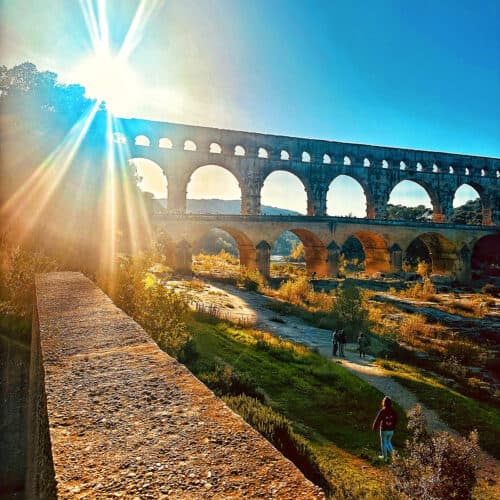
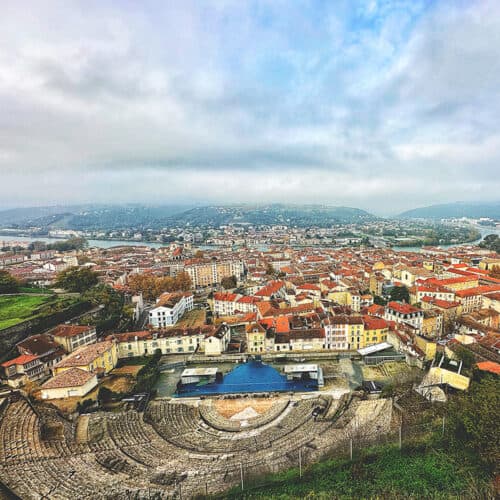

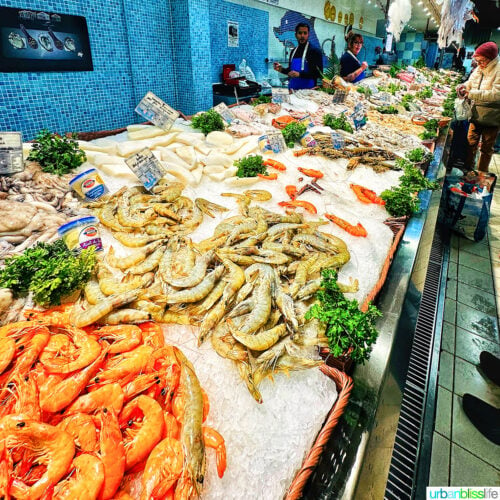
Leave a Reply